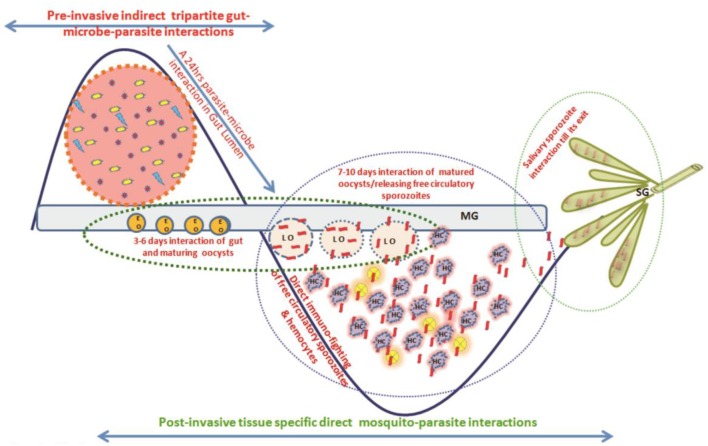Figure 1.
A proposed working hypothesis to decode a system-wide pre and post-gut invasive phases of P. vivax-mosquito interactions: Immediately after an infected blood meal, sexual developmental physiology of Plasmodium rapidly change to adapt mosquitoes' hostile gut-lumen environment and progressively faces gut-microbiota boosted anti-Plasmodium immunity. Though the mechanism that how Plasmodium manages safe journey and survival from gut lumen  gut epithelium
gut epithelium  hemolymph
hemolymph  salivary gland
salivary gland  vertebrate host is not fully known, but we propose and decode (i) a 24–30 h of pre-invasive phase of an indirect gut-microbe-parasite interaction in the gut lumen for ookinetes invasion; and (ii) a longer post-gut invasive, a direct parasite-tissues such as midgut (MG), hemocyte (HC), and salivary gland (SG) interactions, are crucial for the Plasmodium survival (22). Schematically,
vertebrate host is not fully known, but we propose and decode (i) a 24–30 h of pre-invasive phase of an indirect gut-microbe-parasite interaction in the gut lumen for ookinetes invasion; and (ii) a longer post-gut invasive, a direct parasite-tissues such as midgut (MG), hemocyte (HC), and salivary gland (SG) interactions, are crucial for the Plasmodium survival (22). Schematically,  , represents Plasmodium gametocytes;
, represents Plasmodium gametocytes;  and
and  , different bacterial species;
, different bacterial species;  , the mustard yellow circle represents early gut invaded maturing oocysts (EO);
, the mustard yellow circle represents early gut invaded maturing oocysts (EO);  , peach circle with blue dotted boundary is Late rupturing oocysts (LO);
, peach circle with blue dotted boundary is Late rupturing oocysts (LO);  , red ribbon is sporozoite;
, red ribbon is sporozoite;  , salivary lobes;
, salivary lobes;  , the purple cloudy structure is hemocyte.
, the purple cloudy structure is hemocyte.

